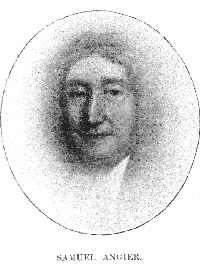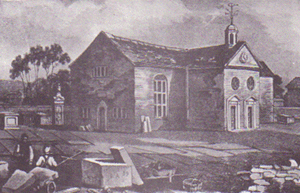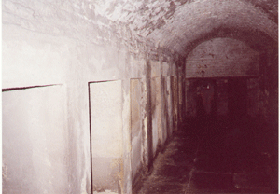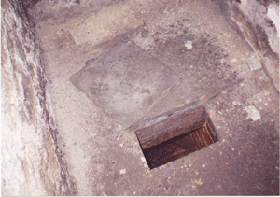Samuel Angier 1639-1713

Samuel Angier was born at Dedham in Essex in 1639, the son of a rich clothier, Bezaleel Angier. His tomb erected by his two sons mistakenly gives his date of birth at 8th October, but in his own diary he gives the date of 8th August. He graduated from Christ Church, Oxford in 1658. He was a protégé of the famous Independent John Owen D.D. When Owen was deprived of the Deanery of Christ Church, Angier, himself ejected in 1662, went to live with him at his house at Stadhampton, Oxfordshire.
During the Great Plague he preached tirelessly from place to place and in 1667, he came to assist his ageing uncle at Denton Chapel. In 1672 under the Indulgence he took out a license as a Presbyterian to preach at the house of Jane Hyde, of Hyde Hall, Denton.
He was ordained with two others in 1672 at the house of the Reverend Robert Eaton at Deansgate, Manchester. His uncle John Angier was present at this, the first nonconformist ordination in the North of England. When John Angier died on the 1st September 1677, the congregation wanted Samuel to succeed him, but the Fellows of Manchester Collegiate Church appointed John Ogden instead; a conformist.
Angier was again excommunicated and forced to conduct services in secret and by 1681 was living in Dukinfield. His register on 29th May that year states, “Father Angier preached first in a building near his home”. An organized raid on this small congregation was only prevented by a sudden storm. His congregation increased rapidly and in 1686 he found it necessary to convert an old barn. On the 11th October 1691 he records in his diary, “I began to preach in my Barn October 10th 1686, which was five years complete yesterday”. The Manchester Barn, the precursor of Cross Street Chapel, was not opened until the year after on the 31st July 1687
His register starts three days before the death of his uncle with the baptism of John, son of Sir Robert Dukinfield on the 28th August 1677. Samuel Angier's entries in the register are an absolute treat to read. They read almost like a diary with entries such as "There have been floods these past five months at Stalybridge" and "Queen Anne was crowned this day".
Services continued in his barn for twenty years before it was decided that a proper church building should be constructed. Robert Dukinfield donated a site near Hall Green for a nominal rent, together with most of the building materials. Building started in 1707 and the church was formally opened on the 19th August 1708. Regular services began on the 29th August 1708 with the first baptism on the 12th September 1708 and the first burial on the 3rd February 1709. For years this old chapel was affectionately known as “The White Chapel” or “Th’Owd Chapel” (see illustration).

Sadly, for many years towards the end of Samuel Angier's life he was almost totally blind. He died in 1713 and his raised boxed tomb is on the right hand side of the church, with inscriptions on the lid entirely in Latin. Like his uncle, they both married into the Mosley family of Manchester. He married Anne, the daughter of Oswald Moseley. She died in 1690 and was buried at the Collegiate Church. His eldest son, was named after his grandfather, Bezaleel, became a physician in London, where he died in 1717. His son John became a Bristol merchant and died there in 1760. His daughter Ann married the Rev. John Cooper of Hyde and Margaret, the Rev. Ralph Lathrop minister of Wem in Shropshire and Ledbury in Hereford.
This building stood for one hundred and thirty nine years until it was destroyed by a great storm in 1839. Samuel Angier's entries in the Parish Register are an absolute treat to read. They read almost like a diary with entries such as "There have been floods these past five months at Stalybridge" and "Queen Anne was crowned this day". He died in 1713 and his raised boxed tomb is on the right hand side of the church, with inscriptions on the lid entirely in Latin. The next incumbent was William Buckley who already held lands in Dukinfield adjoining the hall. The congregation was now the third largest in the country with 793 adherents, nearly a hundred of whom were either gentry, tradesmen or yeomen. People travelled up to ten miles to attend services and had to arrive an hour before the start in order to get a seat. William Buckley was the minister from 1714-1752, and unfortunately, the parish registers for this period have been lost.
Three years ago Dukinfield Old Chapel held an Open Day, where the underground crypt was open for inspection. The Chapel is said to be built on the site of an old pre-Christian site of worship and Chapel Hill is said, by some, to be a dolmenic mound on a reputed ley line. In the crypt is a bottomless well, which is strange on such rising ground.


It was not until William of Orange came to the throne that an ‘Act of Toleration’ was passed on the 24th May 1689, so officially Nonconformist registers only officially start from this date, but the registers at Dukinfield start in 1677.
| Home | Contents | Local Links | Useful Addresses | Family History Links | Forum | Contact |
|
|

